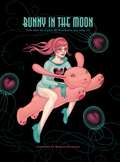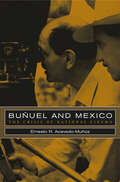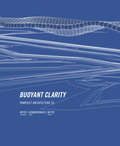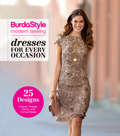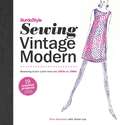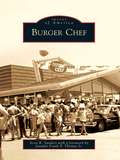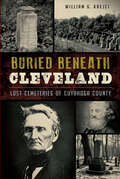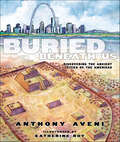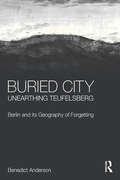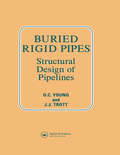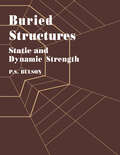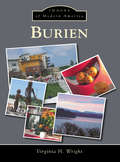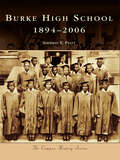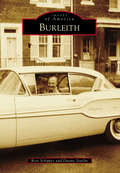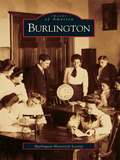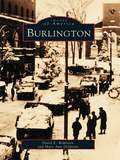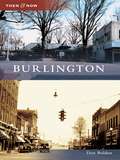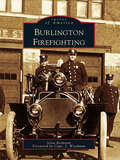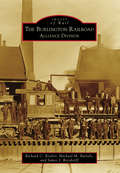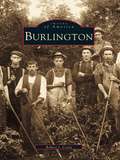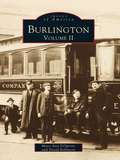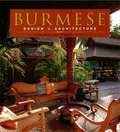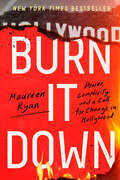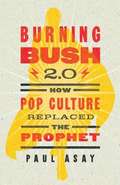- Table View
- List View
Bunny in the Moon: The Art of Tara McPherson vol. 3
by Tara McPhersonGods and devils. Flesh and spirit. Sacred and profane. One of the leading lights of Pop Surrealism, Tara McPherson has traveled the world with her work, gaining new inspirations. Bunny in the Moonfeatures compelling new works and sculpture informed by mythology and folklore. The resulting imagery combines the primal power at the core of ancient culture with McPherson's contemporary explorations of love, loss, strength, vulnerability, and female empowerment.* Foreword by filmmaker Morgan Spurlock (Supersize Me).* Tara's work has been featured in Vanity Fair, The New York Times, and Juxtapoz!
Bunuel and Mexico: The Crisis of National Cinema
by Ernesto R. Acevedo-MuñozThough Luis Buñuel, one of the most important filmmakers of the twentieth century, spent his most productive years as a director in Mexico, film histories and criticism invariably pay little attention to his work during this period. The first book-length English-language study of Buñuel’s Mexican films, this book explores a significant but neglected area of this filmmaker's distinguished career and thus fills a gap in our appreciation and understanding of both Buñuel's achievement and the history of Mexican film. Ernesto Acevedo-Muñoz considers Buñuel's Mexican films—made between 1947 and 1965—within the context of a national and nationalist film industry, comparing the filmmaker's employment of styles, genres, character types, themes, and techniques to those most characteristic of Mexican cinema. In this study Buñuel's films emerge as a link between the classical Mexican cinema of the 1930s through the 1950s and the "new" cinema of the 1960s, flourishing in a time of crisis for the national film industry and introducing some of the stylistic and conceptual changes that would revitalize Mexican cinema.
Buoyant Clarity (Pamphlet Architecture #36)
by Daniel Hemmendinger Christopher Michael Meyer Shawna Michelle MeyerThis newest addition to the Pamphlet Architecture series, long admired for its willingness to propose architectural solutions to challenging problems addresses the issue of rising sea levels with an interrogation of the concept of floating cities, a field of inquiry gaining increasing relevance and urgency with the impending reality of climate change. The authors explore notions of buoyancy and the amphibious through a typology based on human response and adaptation, to one of the hosting pressing issues of our day.
BurdaStyle Modern Sewing - Dresses for Every Occasion (BurdaStyle Modern Sewing)
by Burdastyle MagazineBuild your wardrobe with the latest fashion styles found only from Burda patterns. BurdaStyle Modern Sewing: Dresses for Every Occasion includes 25 projects from the archives of BurdaStyle magazine. All of the must-have essentials of a woman's dress wardrobe are covered in this collection: everything from elegant and sophisticated dresses to casual and comfortable shifts. The fashion styles are versatile and wearable, including flirty halter tops, easygoing pullover styles, retro-remakes, and formfitting classics. The Burda patterns also include skirt and jacket separates for formal occasions that further expand the possibilities for the modern woman's wardrobe. Several of the projects include illustrated step-by-step tutorials. With a few exceptions, all of the projects are easy to intermediate, and sizes range from 2 to 14. Although this book is not meant to be a primer on sewing, it includes a Burda 101 section that covers everything the reader needs to know to follow the patterns.
BurdaStyle Modern Sewing - Wardrobe Essentials: Wardrobe Essentials (BurdaStyle Modern Sewing)
by Burdastyle MagazineBuild your wardrobe with must-have modern basics from the premier name in fashion sewing--BurdaStyle. BurdaStyle is a legendary brand that focuses on the fashionable and high-style sewing marketplace. Sewists know the BurdaStyle name and its reputation for high-quality patterns. BurdaStyle Modern Sewing: Wardrobe Essentials includes 21 projects from the archives of BurdaStyle magazine. All of the must-have basics of a woman's wardrobe are covered in this collection: jackets, pants, blouses, skirts, and dresses. The designs include versatile separates as well as combinations that further expand the possibilities for the modern woman's wardrobe. In addition to the 21 patterns, there are 9 variations. Many of the projects include illustrated step-by-step tutorials. Most of the projects are easy to intermediate, and sizes range from 2 to 14. Wardrobe Essentials includes a Burda 101 section that covers everything the reader needs to know to follow the patterns.
BurdaStyle Sewing Vintage Modern: Mastering Iconic Looks from the 1920s to 1980s
by Nora Abousteit Jamie LauVintage Looks Meet Modern FashionDior's New Look silhouette. Jackie Kennedy's sheath dress. Madonna's bustier. Fashion trends come and go, but certain iconic styles never fade. Make them for yourself with BurdaStyle's new guide to sewing fashion through the decades. Five adaptable master patterns for tops, dresses, and pants are transformed into nineteen unique projects for both women and men that draw inspiration from key fashion moments. These influential looks--from the Roaring Twenties to the Awesome Eighties--are all modernized and reinterpreted for today's sewing enthusiasts. BurdaStyle, the world's largest online community of people who sew, is synonymous with stylish sewing and high-quality patterns. In this follow-up to The BurdaStyle Sewing Handbook, they provide step-by-step instructions and techniques for customizing the enclosed master patterns into new design variations, all perfectly fitted for you. You'll also get a taste of fashion history--the essential designers, signature trends, and style icons from each era--to help you channel your inner Coco Chanel, Audrey Hepburn, or Yves Saint Laurent. BurdaStyle Sewing Vintage Modern combines the best of fashion from the past with an updated approach to sewing. Whether you prefer a slim-fit pant, the perfect men's button-down, or a versatile shift dress, this book offers a classic collection that will last you a lifetime.
Burger Chef
by Scott R. Sanders Frank P. Thomas Jr.Frank P. Thomas Jr., Donald J. Thomas, and Robert E. Wildman, owners of the General Equipment Company, entered into the fast-food business by opening a 15¢ hamburger restaurant called Burger Chef in Indianapolis in 1958. General Equipment was a manufacturer of restaurant machinery and built the equipment installed in each Burger Chef store. The partners started their new Burger Chef division to sell more equipment; they never could have imagined that Burger Chef would eventually grow to become the nation's second-largest hamburger chain and beloved by customers in towns and cities across America. Burger Chef continued in business until 1982, cooking its popular flame-broiled hamburgers and introducing its memorable advertising icons, Burger Chef and Jeff.
Buried Beneath Cleveland: Lost Cemeteries of Cuyahoga County
by William G. Krejci&“His book tells about many of the graves of Revolutionary War and Civil War soldiers, as well as the early pioneers and those who settled the county.&” —Cleveland.com The dead do not always rest in peace. Occasionally, they wind up in the backyard. As towns grew in Cuyahoga County during the late 1800s, many of its cemeteries were relocated to make room for urban sprawl. But not all of these graves made the journey. Author William G. Krejci tracks down more than fifty displaced cemeteries throughout the Greater Cleveland area. Discover the Revolutionary War veterans, famous scientists and illustrious dignitaries found beneath gas stations and grocery stores in this eerie history of Cuyahoga County&’s forgotten dead.
Buried Beneath Us: Discovering the Ancient Cities of the Americas
by Anthony AveniA beautifully illustrated look at the forces that help cities grow—and eventually cause their destruction—told through the stories of the great civilizations of ancient America. You may think you know all of the American cities. But did you know that long before New York, Chicago, Los Angeles, or Boston ever appeared on the map—thousands of years before Europeans first colonized North America—other cities were here? They grew up, fourished, and eventually disappeared in the same places that modern cities like St. Louis and Mexico City would later appear. In the pages of this book, you'll find the astonishing story of how they grew from small settlements to booming city centers—and then crumbled into ruins.
Buried City, Unearthing Teufelsberg: Berlin and its Geography of Forgetting
by Benedict AndersonCities are built over the remnants of their past buried beneath their present. We build on what has been built before, whether over foundations formalising previous permanency or over the temporal occupations of ground. But what happens when you shift a city - when you dislodge its occupation of ground towards a new ground, bury it and forget it? Focusing on Berlin’s destruction during World War II and its reconstruction after the end of the war, this book offers a rethinking of how the practices of destruction and burial combine to reform the city through geography and how burying a city is intricately tied to forgetting destruction, ruination and trauma. Created from 25 million cubic meters of rubble produced during World War II, Teufelsberg (Devil's Mountain) is the exemplar of the destroyed city. Its critical journey is chronicled in combination with Berlin’s seven other rubble hills, and their connections to constructing forgetting through burial. Furthermore, the book investigates Berlin’s sublime relation to Albert Speer’s urban vision to rival the ancient cities of Rome and Athens through their now shared geographies of seven hills. Finally, there is a central focus on the role of the citizens who cleared Berlin’s streets of rubble, and the subsequent human relationships between people and ruins. This book is valuable reading for those interested in Architectural Theory, Urban Geography, Modern History and Urban Design.
Buried Rigid Pipes
by OC Young JJ TrottThis book is specifically concerned with pipes of rigid materials and provides some information on 'flexible' pipes that are available and on their behaviour and use as being of value to the engineer in making an initial choice.
Buried Structures: Static and Dynamic Strength
by Dr P BulsonMuch of the infrastructure of modern society is buried below ground. Pipeline, conduits and culverts carry the services on which our economies depend and the strength and resilience of such structures is of vital importance. Larger underground construction is becoming more common in cities and towns, and in defence installations. This book brings t
Burien (Images of Modern America)
by Virginia H. WrightGiven the beauty of the landscape and its ideal location just south of Seattle, it's easy to understand why Gottlieb Burian set down his 19th-century roots in the land that eventually became the city of Burien. Incorporated in 1993, this gem of a small city sits perched on the edge of Puget Sound, just 15 minutes from SeaTac Airport. With a wealth of arts and cultural groups, an ethnically diverse community of shops and restaurants, a robust medical and wellness community, and city-sponsored public festivals and events throughout the year, Burien offers a wide range of experiences and opportunities for visitors and residents.
Burke High School 1894-2006: 1894-2006 (Campus History)
by Sherman E. PyattIn 1911, the Charleston Colored Industrial School opened its doors to 375 African American boys and girls, making it the first public high school forAfrican Americans in the city of Charleston. Throughout the years, there have been several public high schools in the city that educated AfricanAmerican students. However, they all have closed, and Burke High School (formerly the Charleston Colored Industrial School) is the only public high school in the city that provides an education for children living on the Peninsula. This book explores the rich and unique history of the school from 1894 to 2006 and provides another perspective on the subject of education and African Americans in Charleston during 19th, 20th, and 21st centuries.
Burleith (Images of America)
by Dwane Starlin Ross SchipperKnown as the Village in the City since 1973, Burleith is a small 10-square-block residential community nestled between Georgetown to the south and east and Glover Park to the north. The name “Burleith” dates back to 17th-century Scotland, and the area was first subdivided in 1887 as part of Frederic W. Huidekoper’s Burleith Addition to West Washington. Also known as Georgetown Heights, Burleith caught the attention of Charles Dickens, who wrote in 1842, “The heights of this neighborhood, above the Potomac River, are very picturesque and are free, I should conceive, from some of the insalubrities of Washington.” The Shannon & Luchs real estate firm built the majority of Burleith’s row houses in a predominantly Georgian style during the early 1920s.
Burlington
by Burlington Historical SocietyNestled in the southeastern corner of Wisconsin, Burlington originally blossomed from industrial roots. The city was settled in 1836 by Easterners seeking waterpower for mills at the junction of the White and Fox Rivers. Over the years, the city has grown to attract a wide variety of business, tourism, and families. In the years leading up to the Civil War, Burlington area residents provided hiding places on the Underground Railroad under the leadership of abolitionist Dr. Edward G. Dyer. In the late 1800s, the nearby lakes began attracting summer visitors from Milwaukee and Chicago. Today, the city is home to a Nestle Co. chocolate plant and hosts an annual chocolate festival, earning it the name "Chocolate City."
Burlington
by Mary Ann Dispirito David E. RobinsonNestled on the shores of Lake Champlain, with views of the Adirondacks and Green Mountains, Burlington, Vermont has attracted visitors and residents alike since the late eighteenth century. Lumber, textiles, shipping, the railroad, and higher education contributed to its growth, creating a city with a unique personality. Burlington's story is aboutcommunity and people; sometimes poignant, ofteneccentric, but always intriguing. More than 200 photographs from selected sources take Burlington from 1860 to 1960, and give the reader a glimpse of the people, places, and events that created the city we know today. They include the changing face of the waterfront, the metamorphosis of streets and parks, downtown growth, a variety of prominent residents, and visitors from presidents to national heroes.
Burlington
by Don BoldenBurlington originated as a railroad town but gained worldwide fame as the home of Burlington Industries, once the largest textile maker in the world. Now a city of 50,000 people, it is the national headquarters of Laboratory Corporation of America, the second largest medical testing laboratory in the nation.
Burlington Firefighting (Images of America)
by Liisa Reimann Capt. J. WoodmanBurlington Firefighting richly illustrates the triumphs and tragedies, the hauntings and secrets of the Burlington Fire Department. Originating as a series of bucket brigades, the fire department developed from competing companies that served as elite social clubs into a professional organization that was incorporated in 1895. The transitions from hand-drawn to horse-drawn carts and pumpers to steam engines and motorized trucks largely shaped the evolution of firefighting in Vermont as a whole.
Burlington Railroad, The: Alliance Division
by James J. Reisdorff Michael M. Bartels Richard C. KistlerAlliance has been a railroad center ever since the Burlington Railroad established the city in 1888 while pushing tracks into the vast, open regions of Nebraska, South Dakota, Wyoming, Colorado, and Montana. As a hub for trains carrying a variety of agricultural and mining products to market, Alliance became headquarters in 1902 for the large and geographically diverse area of Burlington train operations called the Alliance Division. For 86 years, the Alliance Division controlled much of the region's rail traffic. Despite the loss of its division point status in 1988, Alliance continues to have its fortunes closely tied to the railroad, now known as the Burlington Northern & Santa Fe. Today, the BNSF funnels large numbers of coal trains through the city while transporting Power River Basin coal to power plants across the nation.
Burlington: America Through Time (Images of America)
by Robert J. CostaKnown as Shawshin by the Native Americans who originally inhabited the region, the town of Burlington has a rich history dating to Colonial and Revolutionary War days. Drawing upon the John Fogelberg collection, the Burlington Historical Commission collection, and the Crawford collection of photographs, now housed in the Burlington Archives, this book presents a vision of Burlington that few will recognize. In Burlington, you will see the people, places, and events that are known today only as legends or place-names. Meet Marshall Simonds, whose generous gift in 1905 gave the town a beautiful park and Burlington Common, as well as its first high school. Experience how townspeople used to celebrate the Fourth of July with a large bonfire on the hill at Simonds Park. Learn of mysteries and disasters, such as the collapse of the parsonage building on the town common after a move in 1956. Explore the historic homes and the buildings and early businesses, which feature scenes from the Reed Ham Works to aerial views of the emerging Burlington Industrial Park. See the images of the Walker, Crawford, and Skelton farms, which showcase the town's fast-disappearing agricultural history.
Burlington: Volume II
by David Robinson Mary Ann DispiritoIn Burlington Volume II, authors Mary Ann DiSpiritoand David Robinson continue the detailed look atthis intriguing Vermont city. Discovered by Samuel deChamplain in 1609, the next few centuries saw Burlington evolve from a wilderness to a small settlement, and eventually, flourish into Vermont's largest city. Situated on the shores of Lake Champlain, Burlington's waterfront area became the early center of commerce in the late eighteenth century with the rise of the lumber industry and the use of ships for transport. By 1865, when Burlington was incorporated as a city, the industries thatprofoundly shaped Burlington's personality were already well established--these included lumber, textiles, shipping, and the railroad, as well as higher education.
Burmese Design & Architecture
by Alfred Birnbaum Luca Invernizzi Tettoni Daniel Hahrs Elizabeth Moore John FalconerBurmese design, heavily influenced by its proximity to China and India, is a many-layered thing, interwoven with spiritual, religious and political messages. Burmese Design & Architecture takes an in-depth look at the entire span of Burmese design, from arts and crafts to both religious and secular architecture. With over 500 full-color photographs and expert insights provided by leading archaeological authorities, this is a must-have for serious connoisseurs of architecture, design or Burma itself.
Burn It Down: Power, Complicity, and a Call for Change in Hollywood
by Maureen RyanNEW YORK TIMES BESTSELLER • LOS ANGELES TIMES BESTSELLERAn NPR Best Book of the YearIn this spectacular, newsmaking exposé that has the entertainment industry abuzz and on its heels, Vanity Fair's Maureen Ryan blows the lid off patterns of harassment and bias in Hollywood, the grassroots reforms under way, and the labor and activist revolutions that recent scandals have ignited.It is never just One Bad Man.Abuse and exploitation of workers is baked into the very foundations of the entertainment industry. To break the cycle and make change that sticks, it’s important to stop looking at headline-making stories as individual events. Instead, one must look closely at the bigger picture, to see how abusers are created, fed, rewarded, allowed to persist, and, with the right tools, how they can be excised.In Burn It Down, veteran reporter Maureen Ryan does just that. She draws on decades of experience to connect the dots and illuminate the deeper forces sustaining Hollywood’s corrosive culture. Fresh reporting sheds light on problematic situations at companies like Lucasfilm and shows like Lost, Saturday Night Live, The Goldbergs, Sleepy Hollow, Curb Your Enthusiasm and more.Interviews with actors and famous creatives like Evan Rachel Wood, Harold Perrineau, Damon Lindelof, and Orlando Jones abound. Ryan dismantles, one by one, the myths that the entertainment industry promotes about itself, which have allowed abusers to thrive and the industry to avoid accountability—myths about Hollywood as a meritocracy, what it takes to be creative, the value of human dignity, and more.Weaving together insights from industry insiders, historical context, and pop-culture analysis, Burn It Down paints a groundbreaking and urgently necessary portrait of what’s gone wrong in the entertainment world—and how we can fix it.
Burning Bush 2.0: How Pop Culture Replaced the Prophet
by Paul AsayMaybe God doesn’t speak through prophets as often these days because he knows people wouldn’t listen. Maybe God speaks to us in different ways—and in the places he knows where we congregate: in our movie theaters, living rooms, iPods, and smartphones. Maybe God still longs to connect with us, and so goes into the places where we’re most likely to listen. Burning Bush 2.0 is a whimsical and sincere examination of the ways God communicates with us—sometimes subtly and secretly—through our media and entertainment streams. Asay examines how faith and God’s fingerprints mark movies and music, television and technology. Through word and picture, God still speaks to us through unsuspecting voices—in ways we’re best able to hear—even if we don’t fully comprehend it completely in the moment. God is everywhere, and doesn’t ask permission to speak, shout out, or whisper his name. Includes study guide for individuals and church groups.
